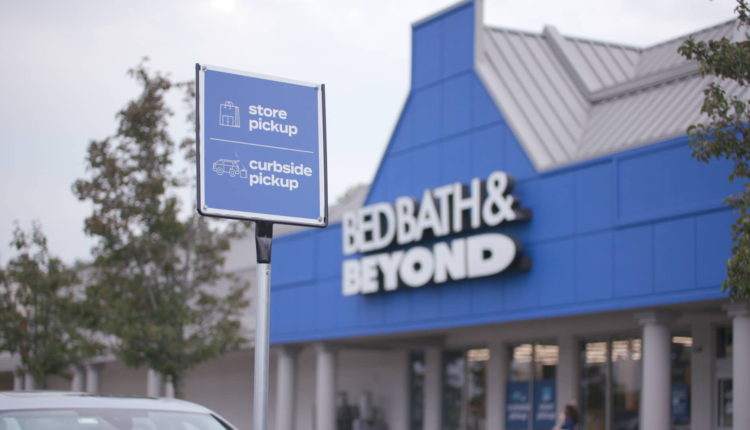Source: Bed Bath & Beyond
Bed Bath & Beyond reported Wednesday a double-digit decline in fiscal fourth-quarter sales, which were pressured by store closures and divestments from a bigger turnaround plan.
Its shares fell more than 9% in midday trading as investors expected to find clearer signs of progress.
“There are some positive things, but it’s still moving,” said Jessica Ramirez, retail analyst for Jane Hali & Associates. “Knowing the Street, they want these turnarounds quite quickly. By this time, investors want things to be a bit in better shape.”
The big-box retailer reaffirmed a prior sales outlook for the coming fiscal year, noting that positive sales momentum has carried into the current quarter. Many Americans have turned to the company’s stores and website during the Covid pandemic to buy cleaning supplies, kitchen appliances and other home items.
However, CEO Mark Tritton told CNBC the company’s fiscal first-quarter results are going to be messy. All Bed Bath & Beyond stores were shut in the year-earlier period due to the health crisis. This made the retailer completely reliant on its digital business to fuel sales. That’s unlike some retailers, notably Walmart and Target, that have been able to keep their stores open throughout the pandemic.
“What you see is some number turbulence,” Tritton said. “You’re going to see a bifurcation in the retail market.”
Here’s how the company did during the quarter ended Feb. 27 relative to what analysts polled by Refinitiv expected:
- Earnings per share: 40 cents adjusted vs. 31 cents expected
- Revenue: $2.62 billion vs. $2.63 billion expected
Bed Bath & Beyond’s net income during the period grew to $9.1 million, or 8 cents per share, compared with a loss of $65.4 million, or 53 cents per share, a year earlier. Excluding one-time adjustments, the company earned 40 cents per share, better than the 31 cents expected by analysts.
Net sales fell about 16% to $2.62 billion from $3.11 billion a year earlier. That was just short of the $2.63 billion analysts were anticipating.
The company said the year-over-year decline was partially driven by the sale of its Christmas Tree Shops and Cost Plus World Market businesses as well as ongoing store closures.
Same-store sales rose 4%. Online sales surged 86% during the fourth quarter, but that wasn’t enough to fully offset the declines of in-store traffic. The company noted 41% of online sales were fulfilled by stores.
Sales within the namesake business grew the most in the home organization category, followed by kitchen food prep, indoor decor and bedding. Same-store sales under the Bed Bath & Beyond banner were up 6%.
Bed Bath & Beyond reaffirmed its fiscal 2021 sales outlook, which calls for revenue to range between $8 billion and $8.2 billion. Analysts were estimating fiscal 2021 sales of $8.18 billion, according to Refinitiv.
The current quarter will be impacted by not only store closures in the year-earlier period, but also by the company’s ongoing restructuring. Its four core banners are Bed Bath & Beyond, Buybuy Baby, Harmon Face Values and Decorist.
The retailer is forecasting first-quarter net sales to increase by more than 40% year over year. Analysts had been calling for a 45.8% jump. Excluding the impact from divested businesses, however, Bed Bath & Beyond said sales from its core banner stores could grow upwards of 65% to 70%.
‘Early days’
Bed Bath & Beyond CEO Mark Tritton
Source: Bed Bath & Beyond
Tritton played a crucial role in driving Target’s turnaround a few years ago. As Target’s chief merchant, he helped the big-box retailer build excitement with customers around exclusive brands and refurbished stores. Wall Street is waiting to see if he can achieve the same success at Bed Bath & Beyond.
As part of Tritton’s turnaround plans, Bed Bath & Beyond is in the process of remodeling 130 to 150 stores this fiscal year. The company plans to remodel 26 stores in the first quarter alone. It just completed its first batch in the Houston market in February.
The retailer said it will spend about $250 million over the next three years to remodel about 450 Bed Bath & Beyond shops in total.
“It’s early days,” Tritton told CNBC about the remodelings. “Normally we have a period of adjustment as we go through every remodel. … It’s about a 12-week process.”
Bed Bath & Beyond is also bolstering its roster of private labels across different home goods categories. It’s planning to launch at least eight brands this year, hoping the exclusivity will be enough to drive people to its stores.
The company debuted last month Nestwell, which sells bed and bath items. Haven, a spa-inspired bath brand, will launch next week.
Bed Bath & Beyond has said it expects its private-label sales will represent 30% of its business within three years, up from about 10% today. The company said these efforts should also help boost its profitability.
As the year progresses, Bed Bath & Beyond expects sequential improvement in profit margins. Its hope is that pressures from heightened freight costs — which have impacted many retailers throughout the pandemic — will ease.
“In 2020, our mix of digital to stores was outsized,” Tritton said. “A digital sale, because of the shipping costs, is always a little different. We’re going to see that recalibrate in 2021.”
The company plans to buy back $325 million of its own stock this year, up from $300 million last year. Its three-year repurchase authorization was increased to $1 billion from $825 million.
Bed Bath & Beyond shares are up about 41% year to date. The company has a market cap just over $3 billion.
Find the full earnings press release from Bed Bath & Beyond here.
—CNBC’s Courtney Reagan contributed to this reporting.


